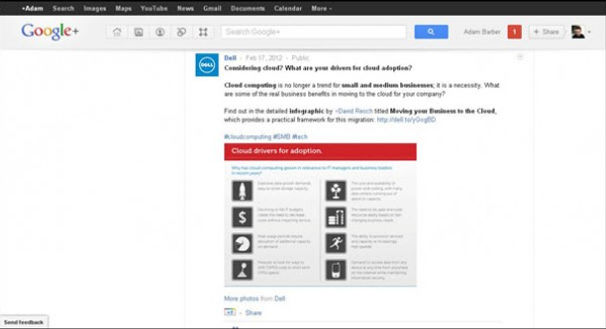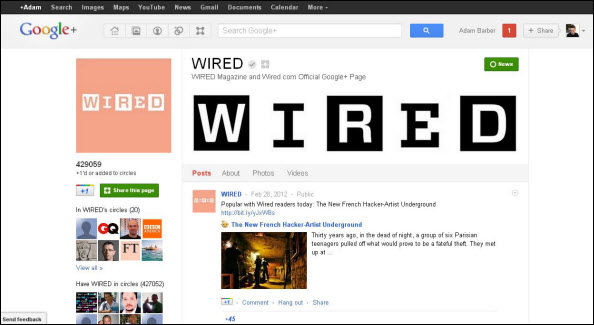Great Content Marketing Ideas for Using Google Plus
- Fahad H

- Mar 26, 2012
- 5 min read
When Google+ was unveiled last year, a lot of content marketers wondered if they really needed another social media platform to develop and maintain. But, with the more recent introduction of
Search Plus Your World, Google+ is getting harder to ignore.
So if you’re still figuring out how to make Google+ part of your content strategy, it might be helpful to take a look at a couple of examples of popular and engaging Google+ pages. I’ve chosen Dell — which has embraced Google+ and is doing some really interesting stuff with its profile — and also “Wired” magazine. Unlike Dell, “Wired” produces content as its core business; but like Dell, it has invested time and resources in its Google+ brand page and has quickly built a large following.
+Dell
Regular updates. One of the first things you’ll notice about Dell’s Google+ page is the regular updates, with one or two new posts going up every day. With Twitter, where each post is under 140 characters and users follow hundreds or even thousands of different accounts, you need volume to get noticed. In contrast, posting too many updates on Facebook is a common reason for people deciding to ditch friends and brands from their newsfeeds.
Google+ has had the Circles function since its inception, which encourages users to filter and organize the people and pages they follow. This reduces the risk that your followers will feel overwhelmed if you post more content than you’d put up on Facebook. But at the same time, Google+ is not Twitter, and users will likely expect a bit more than a stream of shared links.
Rich content. Dell provides a great example of a brand page that fully utilizes the richness of Google+ updates. As I scroll through the recent posts there are some links, but there are also embedded videos, photos, and infographics. This variety of content makes for a great look and feel, and I imagine it’s exactly what the guys at Google were after when they designed an interface that sits somewhere in between a Twitter profile and a blog.
#hashtags and +mentions. Finally, let’s take a quick look at some of Dell’s individual posts, as they provide some good examples you might use on your own Google+ page. There’s a broad range of content — some of which can also be found on Dell’s sites or blogs — but there’s also some relevant third-party stuff.
For example, a recent post linked to a newspaper article that talks about an issue Dell has a keen interest in: the growth of small- and medium-sized businesses (SMEs) in India. Without the character restrictions of Twitter, Dell can provide more value-add when it shares that link, explaining its stake in the story.
The Dell team also points to an infographic on cloud computing, the thumbnail for which adds to the aesthetic appeal of the page. Whenever it shares third-party content, Dell’s team uses hashtags to help its posts get discovered in search, and it uses the “+” feature to let brands and individuals know their content has been featured. This is a good practice to follow with your own Google+ posts, as it will encourage people to add your page to their circles.

Content to share. Dell has some obvious advantages when it comes to running a cool-looking Google+ page: It has the resources in terms of money and manpower to create posts, respond to comments, and keep the page fresh and updated. It also has a large amount of its own content to share, from media releases and blogs to videos and webinars. Dell makes full use of its great range of material on its Google+ page, in each case providing context or pulling out highlights before pointing users to the full or original version.
+ Wired
While Dell has great resources to draw on when it comes to producing and sharing content, content is not its core business. So, the second Google+ example I want a look at is “Wired” magazine, one of the biggest names in technology publishing, with multiple titles in print as well as a renowned website. Like Dell, “Wired” has attracted a strong Google+ following (more than 400,000 people) over a short period of time, with daily updates pointing to third-party content as well as its own website and blogs.
Personalized sharing. Like Dell, “Wired” leverages its existing assets to engage and grow its Google+ community. A number of “Wired” journalists have their own Google+ pages (Chris Anderson, for example, is in 36,000 circles), on which they share their own work as well as content around the web that interests them or that they run across on their beats.
“Wired” shares some of its journalists’ posts on its brand page, which helps to add a human element and trades on its editorial team’s personal authority and followers. If your business has “social friendly” employees, they can be real assets in this way on your social media profiles, not just on Google+, but also on Twitter and, particularly, LinkedIn.
Expanded posts. I’ve already talked about how Google+ encourages users to create rich posts and add some value and context when sharing links. “Wired” features fully expanded posts on its Google+ pages, with some running to more than 200 words — making them more like mini-blog posts.
I think this is a great thing to experiment with on your own Google+ page and helps get you out of the habit of plain old link-sharing. Rather than simply posting “Check this out” because you would like to be associated with it, you can offer your followers some opinion and insight to establish your authority and try to get a conversation going. This will also keep people on your page for longer.
Tapping the archive. Finally, I want to return to “Wired’s” greatest asset: its content. “Wired” produces a wealth of editorial material every day, which means it has no shortage of options when looking to populate its RSS feeds, blogs, and social media profiles.
Something you’ll notice when scrolling through the posts on the “Wired” Google+ brand page is that it features archive content as well as the latest articles. Even if they aren’t new, stories that are getting good traffic on Wired.com or that the staff members feel are worth sharing and likely to attract comment, make ideal Google+ posts. There’s a good lesson here in tapping your own content archive and not just relying on your latest blog posts for something to share.

Google+ numbers
To give you an idea of the growing impact and influence of Google+, here are a few stats:
90 million – total number of Google+ members as of last month (Larry Page, Google CEO)
20 million – unique visitors to Google+ during December 2010 (Compete.com)
576,798 – Dell and Wired’s combined Google+ footprint, March 2012 (Google+)
69.2% – percentage of Google+ users who are men (SocialStatistics.com)
3.86% – percentage of Google+ users living in the world’s Google+ capital, Bangalore, India (NetworkWorld)
3.3 minutes – average time users spent on Google+ during January (comScore)
Do you have any great examples of businesses that are making interesting content plays on Google+? We’d love to hear about your experience with this new content marketing tool.








Comments